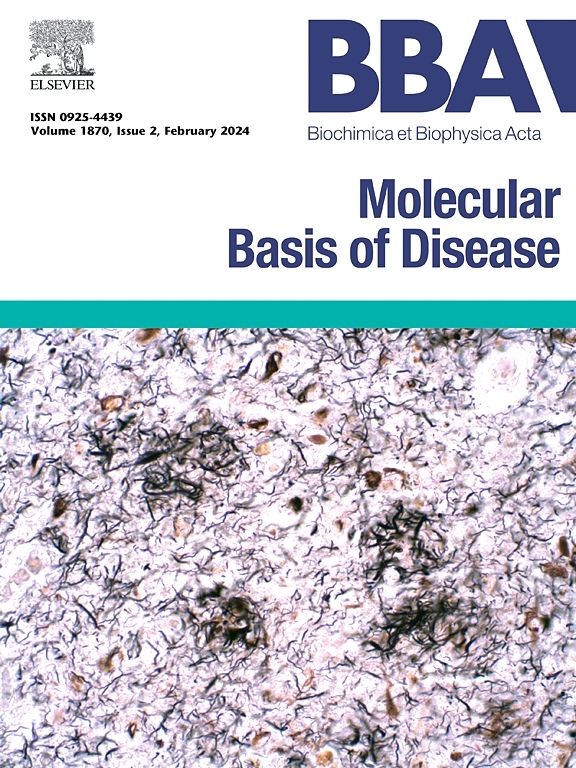PRR 通过激活 Wnt/β-catenin 信号和炎症浸润促进小鼠的高血压肾损伤
IF 4.2
2区 生物学
Q2 BIOCHEMISTRY & MOLECULAR BIOLOGY
Biochimica et biophysica acta. Molecular basis of disease
Pub Date : 2024-09-25
DOI:10.1016/j.bbadis.2024.167517
引用次数: 0
摘要
高血压是慢性肾脏病恶化的一个重要独立风险因素,但其确切的病理机制仍然难以捉摸。我们的初步研究发现,Wnt/β-catenin 可控制肾素-血管紧张素系统(RAS)的表达,从而在高血压和肾脏纤维化的发病机制中发挥重要作用。作为 RAS 的一个组成部分,(原)肾素受体(PRR)在激活 RAS 和高血压中起着至关重要的作用。最近的研究表明,PRR 与 Wnt/β-catenin 信号之间存在相互影响的关系,有可能导致高血压肾纤维化的发展。为了评估 PRR 在介导高血压肾病中的作用,我们通过过度表达 PRR 配体或用 siPRR 阻断 PRR 来操纵这种信号转导。在体内,PRR诱导促进了 Ang II 诱导的高血压小鼠的高血压、蛋白尿、肾脏纤维化、炎症反应和 β-catenin活化。相反,阻断 PRR 可抑制 Ang II 介导的高血压、肾脏纤维化和炎症反应。在体外,PRR 过度表达的肾小管细胞加剧了 Ang II 诱导的纤维化反应和炎症。此外,PRR 在高血压肾病患者中上调,并与肾功能和肾纤维化相关。这些结果表明,PRR与Wnt/β-catenin信号相互作用,促进了高血压肾病的进展。PRR可作为诊断和治疗高血压肾纤维化的生物标志物。本文章由计算机程序翻译,如有差异,请以英文原文为准。
PRR promotes hypertensive renal injury by activating Wnt/β-catenin signaling and inflammation infiltration in mice
Hypertension stands out as a substantial independent risk factor in the progression of chronic kidney disease; however, the exact pathological mechanisms remain elusive. Our preliminary studies find that Wnt/β-catenin control renin-angiotensin system (RAS) expression, thus playing an important role in the pathogenesis of hypertension and renal fibrosis. As an integral component of the RAS, the (pro)renin receptor (PRR) plays a crucial role in the activation of the RAS and hypertension. Recent studies suggest a reciprocal relationship between PRR and Wnt/β-catenin signaling, potentially contributing to hypertensive renal fibrosis development. To assess the role of PRR in mediating hypertensive nephropathy, we manipulated this signaling by over expression of PRR ligand or blockade of PRR by siPRR. In vivo, PRR induction promoted hypertension, proteinuria, renal fibrosis, inflammatory response and β-catenin activation in Ang II induced hypertension mice. Conversely, blockade of PRR inhibited Ang II mediated hypertension, renal fibrosis and inflammation. In vitro, PRR over expression renal tubular cells exacerbated the Ang II induced fibrotic response and inflammation. Moreover, PRR was upregulated in hypertensive nephropathy patients, and correlated with renal function and renal fibrosis. These results indicate that PRR interact with Wnt/β-catenin signaling promote the progression of hypertensive nephropathy. PRR could be served as a biomarker for the diagnosis and treatment of hypertensive renal fibrosis.
求助全文
通过发布文献求助,成功后即可免费获取论文全文。
去求助
来源期刊
CiteScore
12.30
自引率
0.00%
发文量
218
审稿时长
32 days
期刊介绍:
BBA Molecular Basis of Disease addresses the biochemistry and molecular genetics of disease processes and models of human disease. This journal covers aspects of aging, cancer, metabolic-, neurological-, and immunological-based disease. Manuscripts focused on using animal models to elucidate biochemical and mechanistic insight in each of these conditions, are particularly encouraged. Manuscripts should emphasize the underlying mechanisms of disease pathways and provide novel contributions to the understanding and/or treatment of these disorders. Highly descriptive and method development submissions may be declined without full review. The submission of uninvited reviews to BBA - Molecular Basis of Disease is strongly discouraged, and any such uninvited review should be accompanied by a coverletter outlining the compelling reasons why the review should be considered.

 求助内容:
求助内容: 应助结果提醒方式:
应助结果提醒方式:


